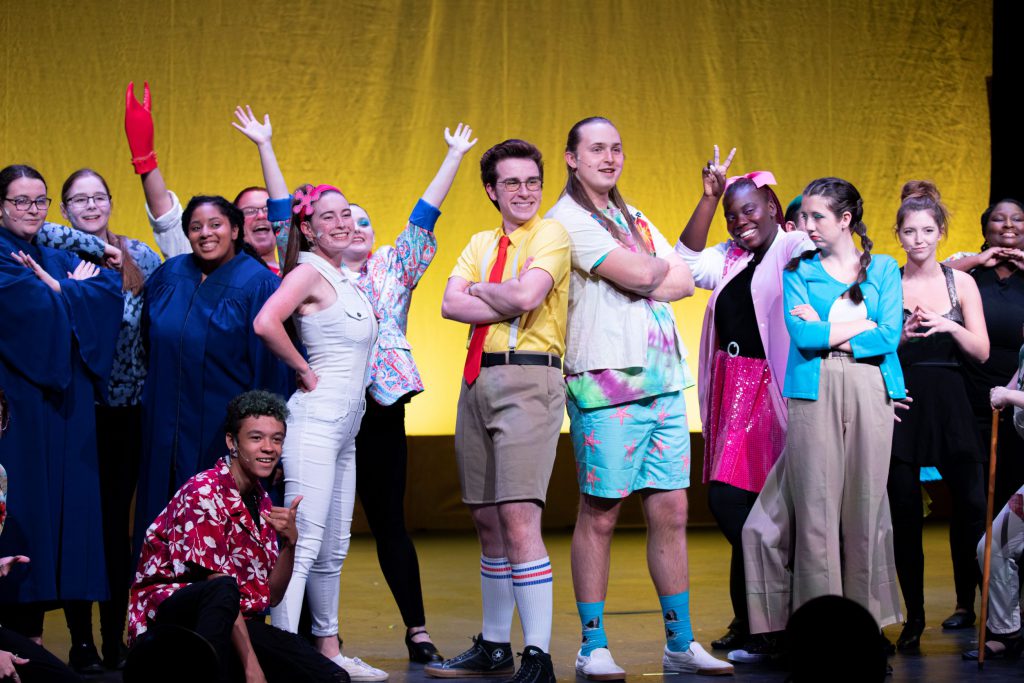
Praying Mantis feeding on a butterfly in the Marlin Meadows outside of Greer.
Kathleen Vanden Berg|Courtesy

Praying Mantis (same as photo on top) trapped in a spider’s web near Greer.
Dr. Marielle Postava-Davignon|Courtesy
When choosing a college or university, students look for a place where they fit in, can feel comfortable and are able to thrive academically. Students want a place they can call “home” for the next four years. Students often find that college campuses aren’t just about studying and classes; they’re also home to long-lasting memories, friends that become family and a variety of wildlife.
From chirping birds, to active squirrels, to flocks of geese covering the many campus lawns, wildlife adds a special touch to campus life here at Virginia Wesleyan University. Every morning, as students are getting ready for their day, the campus comes alive with the sounds of birds chirping, geese honking and car horns beeping at various critters attempting to cross Smith Drive.
“One of the beautiful things about this campus is that we have all of this property and a lot of it is wooded, so [it provides] lots of different types of habitats,” Assistant Professor of Biology Marielle Postava-Davignon said. “It has fostered a really nice diversity of organisms that are not only great for nature in general, but for us to observe and enjoy and study.
Many colleges, such as VWU, strive to make their campuses more wildlife-friendly. VWU has gardens and outdoor spaces created specifically to emphasize wildlife in our community.
“There are a lot of good places for us to go on campus where students can see [wildlife],” Professor of Biology and Environmental Science and Director of Accreditation and Coordinator of Sustainability Management Maynard Schaus said. “Back towards Lake Taylor and the hiking trails that are through the woods and some of the duck ponds that are on campus and even the gardens around Greer, there’s a lot of wildlife that comes in through those habitats.”
Of the vast variety of wildlife found on campus, Canada geese are of the most common. Although they are often considered a nuisance because they impede traffic and leave behind feces, they play an important role in the sustainability of the environment.
“They eat grasses, but they do it in a way, because they’re adapted to the environment, where they’re picking out dead and dying grass,” Postava-Davignon said. “It’s a double-edged sword because they actually do some good things. There can be good and bad sides to a lot of critters.”
Native to Virginia Beach, muskrats are a newly discovered species on campus. Like geese, muskrats have both beneficial and harmful impacts on our campus environment.
“The problem with [muskrats] is they love to burrow, and that’s a real structural problem,” Greer Environmental Sciences Center Gardens Horticulturist and VWU alumnus Skyler Lattuca said. “When you have ponds and infrastructure so close together, they might be creating a den under the sidewalk. All it takes is a couple of years, and that whole thing is going to collapse.”
Because the muskrat is native to the Virginia Beach area, it is more difficult to manage their population on campus; however, VWU has been working with organizations such as the Virginia Department of Wildlife Resources (DWR) to create solutions. Of these solutions, flagging their nests and dams has been the top priority thus far. When it comes to invasive species, such as the Emerald Ash Borer, though, solutions don’t come as easy. These insects present threats to the health of Ash trees, which are abundant in the Wesleyan forests.
“Because we have such a high concentration of [Emerald Ash Borers] and Ash trees, [Ash Borers] pose concern for the campus’s biodiversity,” junior Biology major Marco Molino said. “Obviously, we have a really big problem with invasives, but we’re working on trying to isolate where there are known spots that have infestations of Emerald Ash Borers and trying to understand how they could get to us through different forest corridors.”
Although species like the Canada goose, muskrat and Emerald Ash Borer can sometimes be harmful to our campus environment, they are a part of our community. Students are encouraged to take action when it comes to the issues they pose.
“The more the students start learning and expressing their own ideas of ways to maybe combat this problem, the more Virginia Wesleyan will do something in favor of your opinions,” Lattuca said. “Until that point, though, they’re just going to act in whatever way they see fit.”
The same goes for aiding the University when it comes to maintaining the well-being of our campus wildlife. One step students can take involves assisting with the VWU wildlife database, a site created to form a comprehensive list of species found on or surrounding campus. Students are encouraged to utilize the iNaturalist app in order to make entries to add to the database.
“As we get word out about the campus biodiversity database, I think it’s a great thing for people to engage with each other and kind of participate in this type of citizen science where we can get people reporting on what they see so that we know what’s there,” Postava-Davignon said. “If you see something, say something, because the more we know, the better.”
By taking care of the environment and appreciating the wildlife that inhabit it, students can protect its well-being so it’ll be there for future generations of Marlins to enjoy.
By Kylon Lewis & Carey Seay


